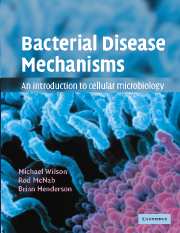Book contents
- Frontmatter
- Contents
- Preface
- Abbreviations used
- Chapter 1 An introduction to bacterial diseases
- Chapter 2 Bacterial cell biology
- Chapter 3 Molecular analysis of bacterial virulence mechanisms
- Chapter 4 Communication in infection
- Chapter 5 The mucosal surface: the front line of antibacterial defence
- Chapter 6 Immune defences against bacteria
- Chapter 7 Bacterial adhesion as a virulence mechanism
- Chapter 8 Bacterial invasion as a virulence mechanism
- Chapter 9 Bacterial exotoxins
- Chapter 10 Bacterial evasion of host defence mechanisms
- Chapter 11 Bacteria in human health and disease: the future?
- Appendix A Glossary of terms used
- Appendix B Brief descriptions of bacteria frequently mentioned
- Index
- Plate section
Chapter 10 - Bacterial evasion of host defence mechanisms
Published online by Cambridge University Press: 05 June 2012
- Frontmatter
- Contents
- Preface
- Abbreviations used
- Chapter 1 An introduction to bacterial diseases
- Chapter 2 Bacterial cell biology
- Chapter 3 Molecular analysis of bacterial virulence mechanisms
- Chapter 4 Communication in infection
- Chapter 5 The mucosal surface: the front line of antibacterial defence
- Chapter 6 Immune defences against bacteria
- Chapter 7 Bacterial adhesion as a virulence mechanism
- Chapter 8 Bacterial invasion as a virulence mechanism
- Chapter 9 Bacterial exotoxins
- Chapter 10 Bacterial evasion of host defence mechanisms
- Chapter 11 Bacteria in human health and disease: the future?
- Appendix A Glossary of terms used
- Appendix B Brief descriptions of bacteria frequently mentioned
- Index
- Plate section
Summary
Aims
The principal aims of this chapter are to describe:
the concept of bacterial evasion of host defences
the means by which bacteria overcome mucosal defence mechanisms
how bacteria counteract cytokine-mediated host defences
the mechanisms used by bacteria to evade the innate and acquired immune systems
how bacteria use apoptosis and control the host cell cycle in order to evade host defences
Introduction
Chapters 5 and 6 have introduced the reader to the overlapping systems of cells and molecules that mammals have evolved to defend against bacterial infection. Our protective systems of immunity and inflammation involve a range of cells (macrophages, dendritic cells, T lymphocytes, endothelial cells, etc.), cellular receptors (CD14, Toll-like receptors (TLRs), T cell receptors (TCRs), etc.), humoral effector molecules (antibacterial peptides, complement components, acute phase proteins, antibodies, etc.) and a growing array of integrating signals (cytokines and lipid mediators such as prostaglandins and lipoxins). As we learn more about the bacteria that share their lives with us, we appreciate just how many counter-measures they have evolved to help defeat our myriad systems of immunity (Figure 10.1). However, it is important to realise that the evolution of counter-measures is a two-way process, in other words it is a co-evolutionary process, which results ultimately in the survival of both the pathogen and the host.
This chapter will begin by considering the mechanisms of microbial evasion of host immunity at mucosal surfaces, and will then turn to how viruses and bacteria interfere with the integrating signals of immunity – the cytokines.
- Type
- Chapter
- Information
- Bacterial Disease MechanismsAn Introduction to Cellular Microbiology, pp. 514 - 582Publisher: Cambridge University PressPrint publication year: 2002
- 1
- Cited by



